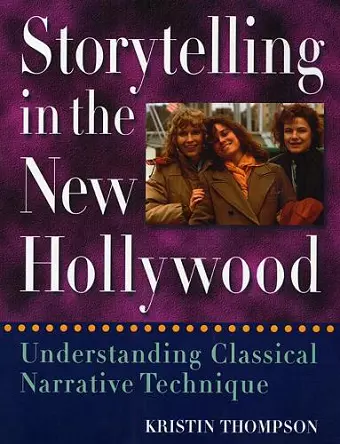Storytelling in the New Hollywood
Understanding Classical Narrative Technique
Format:Paperback
Publisher:Harvard University Press
Published:5th Dec '99
Currently unavailable, and unfortunately no date known when it will be back

It was wonderful to read a book where I felt the writer knew what was going on in my mind while I was directing the film. Kristin Thompson was able to illuminate all the structural twists and turns of the plot, the character development, as well as the small details and symbolic references that directors put into their work, but often go unnoticed by the average moviegoer. -- Susan Seidelman, Director Desperately Seeking Susan
Drawing on a wide range of films from the 1920s to the 1990s—from Keaton’s Our Hospitality to Casablanca to Terminator 2, Kristin Thompson offers the first in-depth analysis of Hollywood’s storytelling techniques and how they are used to make complex, easily comprehensible, entertaining films.
In a book as entertaining as it is enlightening, Kristin Thompson offers the first in-depth analysis of Hollywood's storytelling techniques and how they are used to make complex, easily comprehensible, entertaining films. She also takes on the myth that modern Hollywood films are based on a narrative system radically different from the one in use during the Golden Age of the studio system.
Drawing on a wide range of films from the 1920s to the 1990s--from Keaton's Our Hospitality to Casablanca to Terminator 2--Thompson explains such staples of narrative as the goal-oriented protagonist, the double plot-line, and dialogue hooks. She domonstrates that the "three-act structure," a concept widely used by practitioners and media commentators, fails to explain how Hollywood stories are put together.
Thompson then demonstrates in detail how classical narrative techniques work in ten box-office and critical successes made since the New Hollywood began in the 1970s: Tootsie, Back to the Future, The Silence of the Lambs, Groundhog Day, Desperately Seeking Susan, Amadeus, The Hunt for Red October, Parenthood, Alien, and Hannah and Her Sisters. In passing, she suggests reasons for the apparent slump in quality in Hollywood films of the 1990s. The results will be of interest to movie fans, scholars, and film practitioners alike.
Thompson...trespasses on the turf of the screenwriting gurus here, gun in hand, to blast away at the three-act structure universally accepted in the business since Syd Field codified it in his 1979 book Screenplay. In its place she proposes four acts, sections of roughly equal length which she labels 'setup,' 'complicating action,''development' and 'climax and epilogue.' -- Alistair Owen * The Independent *
It was wonderful to read a book where I felt the writer knew what was going on in my mind while I was directing the film. Kristin Thompson was able to illuminate all the structural twists and turns of the plot, the character development, as well as the small details and symbolic references that directors put into their work, but often go unnoticed by the average moviegoer. -- Susan Seidelman, Director Desperately Seeking Susan
Thompson's insightful analysis of Ground Day and of the screenwriting process in general should be fascinating toboth writers and audience alike. More thoughtful writing and more discerning audiences can't help but lead to better movies, and this informative and provocative book is a step in that direction. -- Harold Ramis, Director, Ground Day
How refreshing to encounter a film scholar who understands that, first and foremost, movies must be written. Thompson's book offers an invaluable resource not only to professionals, but to any dedicated moviegoer who wants to better understand the intricate cratf of telling stories on film. -- Ted Tally, Screenwriter, The Silence of the Lambs
ISBN: 9780674839755
Dimensions: unknown
Weight: 699g
416 pages